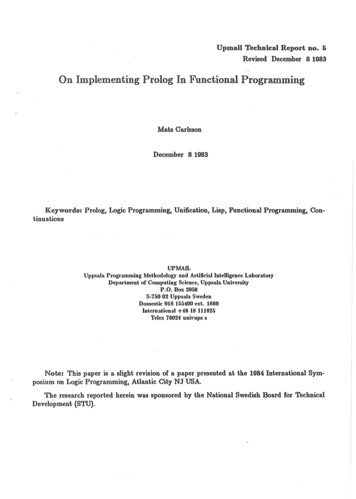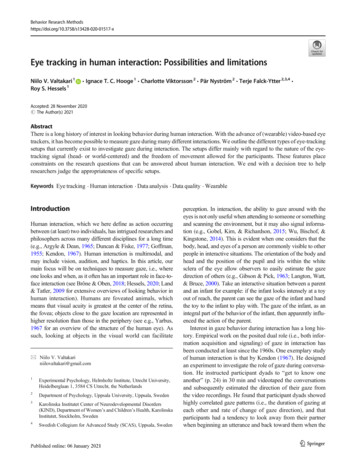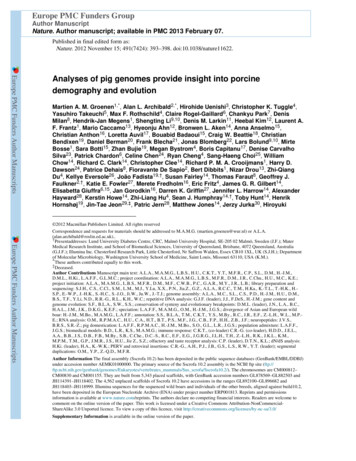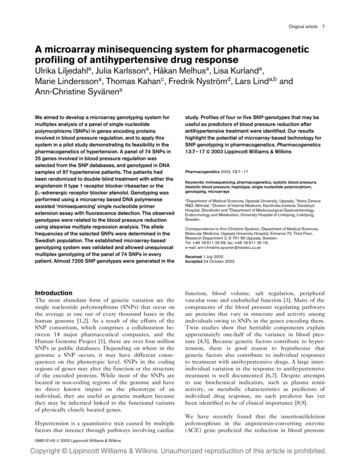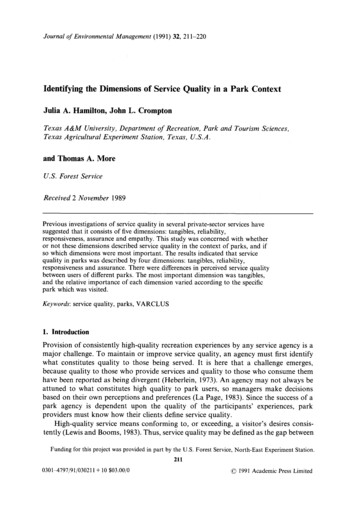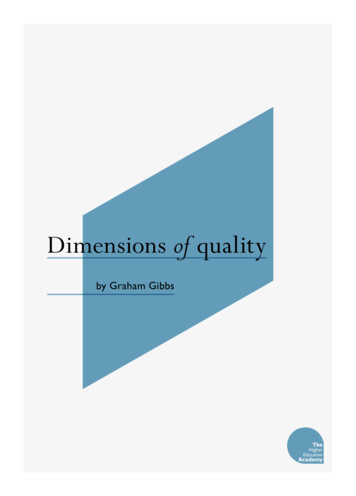
Transcription
Dimensions of qualityby Graham Gibbs
The higher Education AcademyThe views expressed in this publication are those ofthe authors and not necessarily those of the HigherEducation Academy.ISBN 978-1-907207-24-2 The Higher Education AcademySeptember 2010The Higher Education AcademyInnovation WayYork Science ParkHeslingtonYork YO10 5BRwww.heacademy.ac.ukTel: 44 (0)1904 717500Fax: 44 (0)1904 717505All rights reserved. Apart from any fair dealingfor the purposes of research or private study,criticism or review, no part of this publication maybe reproduced, stored in a retrieval system, ortransmitted, in any other form or by any othermeans, graphic, electronic, mechanical, photocopying,recording, taping or otherwise, without the priorpermission in writing of the publishers.To request copies of this report in large print or in adifferent format, please contact the Academy.Designed by Daniel GrayPrinted by The Charlesworth Group2
Dimensions of qualityby Graham Gibbs2Foreword by Craig Mahoney41. Executive summary82. Introduction11 3. The nature of dimensions of quality144. Presage dimensions of quality195. Process dimensions386. Product dimensions of educational quality437. Summary and conclusions508. About the author519. Acknowledgements5210. References
The higher Education AcademyForewordThe perennial debate about what constitutes quality in undergraduate education hasbeen reignited recently, not least by a range of published research, Select Committeeactivity, tightening of resource, and the large-scale review by Lord Browne.As the organisation dedicated to enhancing the quality of students’ learningexperiences, the Higher Education Academy is pleased, through this piece of work, tocontribute further to this important debate.Our starting-point is twofold: first, that higher education should be atransformative process that supports the development of graduates who can makea meaningful contribution to wider society, local communities and to the economy.Second, that any discussion around quality needs to be evidence-informed. As aresult, we identified a need to synthesise and make sense of the scattered researchin the field of higher education quality. We wanted to find out what the researchevidence tells us and what further work we can do to apply the relevant findings inour quest to improve the quality of student learning in UK higher education.Graham Gibbs states that the most important conclusion of this report is thatwhat best predicts educational gain is measures of educational process: in otherwords, what institutions do with their resources to make the most of the studentsthey have. Examining the evidence, he draws conclusions about some key topics thathave been the subject of much debate around quality. For example, he concludesthat the number of class contact hours has very little to do with educational quality,independently of what happens in those hours, what the pedagogical model is, andwhat the consequences are for the quantity and quality of independent study hours.He also reiterates research (Nasr et al., 1996) that shows that teachers who haveteaching qualifications (normally a Postgraduate Certificate in Higher Education, orsomething similar) have been found to be rated more highly by their students thanteachers who have no such qualification. I think this is a crucial point. At the Academywe believe that high quality teaching should be delivered by academic staff who areappropriately qualified and committed to their continuing professional development.To this end we will continue to provide and develop an adaptable framework foraccredited teaching qualifications in HE, incorporating the UK Professional StandardsFramework and other relevant teaching qualifications. We will also continue to workwith HEIs to develop and manage CPD frameworks for learning and teaching.The report also concludes that some dimensions of quality are difficult toquantify, and it is therefore difficult to see what effect they might have. Aspects of2
Dimensions of qualit ydepartmental culture are one such area: whether teaching is valued and rewarded,whether innovation in teaching is systematically supported and funded, etc. TheAcademy has already conducted research into the reward and recognition of teachingwhich showed that over 90% of academic staff thought that teaching should beimportant in promotions. We will continue to focus on this work.Some of the findings of this report may confirm aspects of institutional policyon enhancing quality, some of them will prompt new and different approaches tofocused investment of funding and expertise in order to maximise educational gain,particularly at a time of diminishing resource. Some of them will call into questionthe efficacy and appropriateness of practices and policies, and cause us to look not athow much is spent per capita, but on how it is spent; less on how many contact hoursare provided but with whom and with what consequences for independent learning;on the extent to which we truly support and adopt the kinds of pedagogic practicesthat engender students’ intrinsic engagement in their learning.Graham argues for a better focus on evidence in order to understand qualityproperly, to ensure that our quality process are informed to a greater extent by whatwe know about what constitutes effective practice and about the extent to whichthese practices are employed, to make better and more coordinated use of the fullrange of available data, and to understand the relationship between them.This paper is primarily for an audience of senior managers of HEIs – thecolleagues who develop and implement the kinds of institutional policies that havethe propensity to improve student learning and who conceptualise the frameworksto support that vital process. We hope that this report will meaningfully inform bothpolicy and practice and look forward to following up this work in the coming monthsby engaging with you in debates and discussions about the dimensions of quality.Professor Craig MahoneyChief ExecutiveThe Higher Education Academy.3
The higher Education Academy1.Executive summary“ A serious problem with national magazine rankings is that froma research point of view, they are largely invalid. That is, they arebased on institutional resources and reputational dimensions whichhave only minimal relevance to what we know about the impactof college on students Within college experiences tend to countsubstantially more than between college characteristics.”—Pascarella, 20011.1The focus of the reportThis report has been written to contribute to the current debates about educationalquality in undergraduate education in the UK, and about the need to justify increasesin resources on the basis of indicators of educational quality. This report will identify arange of dimensions of quality and examine the extent to which each could be considereda valid indicator, with reference to the available research evidence. It attempts to identifywhich kinds of data we should take seriously and which we should be cautious of placingweight on. Some of these dimensions we might be wise to pay attention to currently lacka solid evidence base, especially in relation to research carried out in the UK context, andso the report also identifies priorities for research and for data collection and analysis.1.2 T he approach taken to considering dimensions of qualityThe report identifies which dimensions of educational quality can reasonably beused to compare educational settings. It adapts Biggs’s ‘3P’ model (Biggs, 1993) of‘presage’, ‘process’ and ‘product’ to categorise the variables under consideration(see Section 3.2). The report examines a wide range of potential indicators. Presagevariables define the context before students start learning, process variables describewhat goes on as students learn, and product variables relate to the outcomes ofthat learning. For presage and process variables the available evidence is examinedconcerning the validity of the variable: the extent to which it predicts studentlearning outcomes and educational gains. Each product variable is examined for itsability to indicate comparative quality.4
Dimensions of qualit y1.3 T he limitations of presage and product variablesPresage variables such as funding, research performance and, the reputation thatenables an institution to have highly selective student entry, do not explain muchof the variation between institutions in relation to educational gains. Measures ofeducational product such as grades do reflect these presage variables, but largelybecause the best students compete to enter the best-funded and most prestigiousinstitutions and the quality of students is a good predictor of products. Measuresof product such as retention and employability are strongly influenced by a raft ofpresage variables that go well beyond those used by HEFCE in setting performancebenchmarks. The lack of comparability of degree standards proves an obstacle tointerpretation of student performance data in the UK. This makes interpreting andcomparing institutional performance extremely difficult.1.4The importance of process variablesWhat best predicts educational gain is measures of educational process: whatinstitutions do with their resources to make the most of whatever students theyhave. The process variables that best predict gains are not to do with the facilitiesthemselves, or to do with student satisfaction with these facilities, but concern asmall range of fairly well-understood pedagogical practices that engender studentengagement. In the UK we have few data about the prevalence of these educationalpractices because they are not systematically documented through quality assurancesystems, nor are they (in the main) the focus of the National Student Survey.Class size, the level of student effort and engagement, who undertakes theteaching, and the quantity and quality of feedback to students on their work are allvalid process indicators. There is sufficient evidence to be concerned about all four ofthese indicators in the UK.1.5The importance of multivariate analysisFew relationships between a single dimension of quality and a single measure of eithereducational performance or educational gain can be interpreted with confidencebecause dimensions interact in complex ways with each other. To understand whatis going on and draw valid conclusions it is necessary to have measures of a range ofdimensions of quality at the same time and to undertake multivariate analysis. Largescale multivariate analyses have been repeatedly undertaken in the US, and havesuccessfully identified those educational processes that affect educational gains, andthose that do not or that are confounded by other variables. In contrast there hasbeen little equivalent analysis in the UK. This is partly because data in the UK that5
The higher Education Academycould form the basis of multivariate analysis for that purpose are currently collectedby different agencies and have never been fully collated.1.6The importance of educational gainBecause educational performance is predicted by the entry standards of students,to compare institutional performance in a valid way it is necessary to measureeducational gain: the difference between performance on a particular measure beforeand after the student’s experience of higher education. While the most influentialUS studies measure educational gain in a variety of ways, there is very little evidenceavailable in the UK about educational gain.1.7 Dimensions of quality in different kinds of institutionsInstitutions have different missions, and comparing them using product dimensions ofquality that are the goals of only a subset of the institutions leads to conclusions ofdoubtful value. Process dimensions give a fairer comparative picture of quality thando presage or product dimensions. However, different pedagogic phenomena, andhence different process variables, are likely to be salient in different institutions. Forexample, only some of the very different ways in which The Open University or theUniversity of Oxford achieve such high National Student Survey ratings are relevantto other kinds of university.1.8 Dimensions of quality in different departmentsIndicators of dimensions of quality often vary widely between departments withinthe same institution, for a variety of reasons. Prospective students need qualityinformation about the specific degree programme they wish to study at an institutionrather than about institutional averages or about clusters of degree programmesaggregated into ‘subjects’ as at present. Providing such information at a sufficient levelof granularity may be impractical.1.9 Dimensions of quality that are difficult to quantifyStudies of the characteristics of both institutions and departments that have been foundto be outstanding in terms of valid dimensions of educational quality have identifiedprocess variables that would be extremely difficult to quantify or measure in a safe way,such as the extent to which teaching is valued, talked about and developed.6
Dimensions of qualit y1.10Evidence of the products of learningOne of the most telling indicators of the quality of educational outcomes is the workstudents submit for assessment, such as their final-year project or dissertation. Thesesamples of student work are often archived, but rarely studied. There is considerablepotential for using such products as more direct indicators of educational quality thanproxies such as NSS scores.1.11 he potential for improved quality, and the evaluation ofTimprovements in qualityThere is clear evidence that educational performance and educational gains can beenhanced by adopting certain educational practices. In the US the National Surveyof Student Engagement (NSSE) has been used successfully by many institutionsto identify where there are weaknesses in current educational processes and todemonstrate the positive impact of the introduction of certain educational practices.Pooling data across such innovations then provides a valid basis to guide otherinstitutions in the adoption of practices that are likely to be effective. The NSScannot be used in the UK in the same way, despite its reliability. There is a valuablerole to be fulfilled by national agencies in supporting the use of valid measures of theimpact of changed educational practices, and in pooling evidence across institutions.1.12 T he potential for informing potential students about qualityIt seems unlikely that comparative indicators of quality currently available in the UKcould provide prospective students with a valid basis to distinguish between individualcourses with regard to their educational quality. The collation of currently availabledata into league tables is invalid and misleading. Even in the US where a range ofmore valid indicators are more widely available, those responsible for collecting andinterpreting the data counsel strongly against their collation into a single league table.7
The higher Education Academy2.IntroductionThe extent to which indicators of quality have shaped both the politics of highereducation and institutional priorities is not a new phenomenon (Patrick and Stanley,1998). However, there is currently increased emphasis on the overall quality ofundergraduate education in the UK. Data from a number of recent surveys andstudies have raised challenging issues about:—— differences in quality between institutions within the UK that in the pasthave, rightly or wrongly, been assumed to be broadly comparable;—— differences in quality between national higher education systems, to whom in thepast the UK has been assumed, rightly or wrongly, to be superior, in the contextof an increasingly competitive international higher education market place;—— the adequacy of national quality regimes that have emphasised scrutiny ofan institution’s quality assurance to a greater extent than of its educationalprocesses or outcomes of the kind emphasised in some of the recent highprofile surveys and studies.A Parliamentary Select Committee (House of Commons, 2009) has takenevidence from a wide range of sources and reached challenging conclusions both aboutthe quality of UK higher education and how that quality can be assured in the future.Among all the debate there has sometimes been uncritical acceptance ofsome sources of evidence that cannot bear the weight of interpretation, and alsorejection of evidence that deserves to be taken more seriously. Even in publicreports argument has sometimes made no use of available evidence. To give oneexample the Quality Assurance Agency (2009) has responded to data that suggestboth that UK students might study significantly less hard than their Europeancounterparts, and that there are wide differences between institutions and subjectswithin the UK in relation to how many hours are studied (HEPI, 2006, 2007;Brennan et al., 2009). From the perspective of the current report the key questionsin this case are:—— does it matter that some students receive less class contact than others?Are class contact hours an indicator of quality?—— does it matter that some students put in less total effort than others? Aretotal student learning hours an indicator of quality?8
Dimensions of qualit yIn Section 5.2 below, evidence is reviewed that might inform the QAA’s currentposition on this issue.Similarly the findings of a study of student experience by the National Union ofStudents (NUS, 2008) might be interpreted differently if they were informed by theavailable empirical evidence on the issues it addresses, such as the effects of paidwork on students’ study hours.The literature on the validity of indicators of quality is vast, widely dispersedand mostly American. It tends to be focused on specific purposes, such as critiquinga particular university league table, critiquing a particular government-definedperformance indicator, establishing the characteristics of a particular student feedbackquestionnaire, or examining the characteristics of a particular indicator (such asresearch performance). Much of this literature is technical in nature and written fora specialist audience of educational researchers. The current report attempts tobring much of this diverse literature together encompassing many (though not all)dimensions of quality. It is not intended to be an exhaustive account, which would be avery considerable undertaking, and it is written for a general audience. It will not delveinto statistical and methodological minutiae, although sometimes an appreciation ofstatistical issues is important to understanding the significance of findings.This report is intended to inform debate by policy formers of four main kinds:those concerned about the overall quality of UK higher education; those concernedwith institutional and subject comparisons; those concerned with funding on the basisof educational performance and those within institutions concerned to interprettheir own performance data appropriately. It may also be useful to those directingresources at attempts to improve quality as it identifies some of the educationalpractices that are known to have the greatest impact on educational gains.It is important here to be clear what this report will not do. It will not reviewalternative quality assurance regimes or make a case for any particular regime.In identifying dimensions of quality that are valid it will, by implication, suggestelements that should be included in any quality assurance regime, and those thatshould not be included.The report will not be making overall comparisons between the UK and otherHE systems, between institutions within the UK, between subjects nationally orbetween subjects or departments within institutions. Rather the purpose is toidentify the variables that could validly be used in making such comparisons.The report is not making a case for performance-based funding. Reviews ofthe issues facing such funding mechanisms can be found elsewhere (Jongbloed andVossensteyn, 2001). However, valid indicators of quality will be identified that anyperformance-based funding system might wish to include, and invalid indicators willbe identified that any performance-based system should eschew.Finally, the report is not making a case for the use of ‘league tables’ based oncombinations of quality indicators, nor does it consider the issues involved in thecompilation and use of existing or future league tables. Trenchant and well-founded9
The higher Education Academycritiques of current league tables, and of their use in general, already exist (Bowden,2000; Brown, 2006; Clarke, 2002; Eccles, 2002; Graham and Thompson, 2001; Kehmand Stensaker, 2009; Thompson, 2000; Yorke, 1997). Some of these critiques coversimilar ground to parts of this report in that they identify measures commonly usedwithin league tables that are not valid indicators of educational quality.Throughout the report there is a deliberate avoidance of using individualinstitutions in the UK as exemplars of educational practices, effective or ineffective,with the exception of a number of illustrations based on The Open University andthe University of Oxford. Despite being far apart in relation to funding, they areclose together at the top of rankings based on the NSS. They have achieved thisusing completely different educational practices, but these practices embody someimportant educational principles. They are so different from other institutions thatthere can be little sense in which they can be compared, or copied, except at thelevel of principles. It is these principles that the report seeks to highlight, becausethey illuminate important dimensions of quality.10
Dimensions of qualit y3.The nature of dimensions of quality3.1Conceptions of quality‘Quality’ is such a widely used term that it will be helpful first to clarify the focusof this report. There have been a number of attempts to define quality in highereducation, or even multiple models of quality (e.g. Cheng and Tam, 1997). The mostcommonly cited discussion of the nature of quality in higher education in the UK isthat by Harvey and Green (1993), and their helpful nomenclature will be employedhere. First, quality is seen here as a relative concept – what matters is whether oneeducational context has more or less quality than another, not whether it meetsan absolute threshold standard so that it can be seen to be of adequate quality,nor whether it is reaches a high threshold and can be viewed as outstanding andof exceptional quality, nor whether a context is perfect, with no defects. What isdiscussed here is the dimensions that are helpful in distinguishing contexts from eachother in terms of educational quality.Quality may also be seen to be relative to purposes, whether to the purposesand views of customers or relative to institutional missions. This report doesnot take customer-defined or institutionally defined conceptions of quality as itsstarting point. Rather an effort will be made to focus on what is known about whatdimensions of quality have been found to be associated with educational effectivenessin general, independently of possible variations in either missions or customers’perspectives. The report will then return to the issue of institutional differences andwill comment in passing on differences between students in the meaning that can beattached to quality indicators such as ‘drop-out’.A further conception of quality made by Harvey and Green is that of qualityas transformation, involving enhancing the student in some way. This conceptioncomes into play when examining evidence of the educational gains of students (incontrast to their educational performance). This transformation conception ofquality is also relevant when examining the validity of student judgements of thequality of teaching, where what they may want teachers to do may be known fromresearch evidence to be unlikely to result in educational gains. What is focused onhere is not necessarily what students like or want, but what is known to work interms of educational effectiveness.It is usual to distinguish between quality and standards. This distinction is mostrelevant in Section 6.1 on student performance, where the proportion of ‘good11
The higher Education Academydegrees’ can be seen to be in part a consequence of the qualities of what studentshave learnt and in part a consequence of the standards applied in marking theproducts of student learning. This report will not focus on standards that have beenthe subject of much recent debate; for example, concerning the operation of theexternal examiner system.3.2 Categorising dimensions of quality: presage, process and productEducation is a complex business with many interacting dimensions of quality in manyvaried contexts. To understand what is going on it is necessary to have a way ofconceiving of the variables involved and of organising and interpreting studies of therelationships between these variables. This report will adopt the commonly used ‘3P’model (Biggs, 1993), which approaches education as a complex system with ‘Presage’,‘Process’ and ‘Product’ variables interacting with each other. The ‘3P’ model isessentially the same as that used by large-scale studies in the US (e.g. Astin, 1977,1993): the ‘Input-Environment-Output’ model. Presage variables are those that existwithin a university context before a student starts learning and being taught, andinclude resources, the degree of student selectivity, the quality of the students, thequality of the academic staff and the nature of the research enterprise. None of thesepresage variables determine directly how the educational process may be conducted,although they often frame, enable or constrain the form education takes.Process variables are those that characterise what is going on in teachingand learning and include class size, the amount of class contact and the extent offeedback to students. Process variables also include the consequences of variablessuch as class size for the way students go about their learning, e.g. how thosevariables impact on the quantity and quality of their study effort and their overalllevel of engagement.Product variables concern the outcomes of the educational processes andinclude student performance, retention and employability. Products can also includepsychometric measures of generic outcomes of higher education, such as students’ability to solve problems. In some studies the key product measure is not studentperformance, but educational gain: the difference between performance on aparticular measure before and after the student’s experience of higher education. Thedifference between performance and gain will be crucial in understanding dimensionsof quality, as we shall see.The categorisation of variables as presage, process or product is not alwaysstraightforward. For example, some process variables such as the level of studentengagement may be related to other process variables, such class size, which mayin turn be related to funding levels. Which are the presage variables and whichthe products? Class size is not seen as a presage variable in the 3P model as it isin part a consequence of policy decisions about how to use resources and in part12
Dimensions of qualit ya consequence of educational decisions about teaching methods. The presagevariable of resources does not necessarily predict either. Nor is student engagementconceived of in the 3P model as a product. Both class size and student engagementare conceived of as part of the processes that may influence education outcomes,which are categorised as products.In examining the usefulness of potential performance indicators involvedin ‘league tables’, presage, process and product variables have sometimes beensubdivided into more categories within a more complex model (Finnie and Usher,2005; Usher and Savino, 2006), but for the purposes of this report the simple 3Pmodel will suffice.This report examines a wide range of presage, process and product variables inturn, and in doing so identifies relationships that are known to exist between them.13
The higher Education Academy4.Presage dimensions of qualityThis section considers four presage dimensions of quality:funding, staff:student ratios, the quality of teaching staff and thequality of students4.1FundingInstitutional funding predicts student performance to some extent. It predictscohort size (Bound and Turner, 2005), and class size predicts student performance(see Section 5.1). Funding also affects the kind of teachers the institution can affordto undertake the teaching and this affects student performance (see Section 4.3).How much funding per student is allocated to the provision of learning resourcesalso predicts student study effort, which in turn predicts student performance(see Section 5.2). However, funding predicts performance largely because the beststudents go to the best-resourced institutions and the quality of the students predictstheir performance (see Section 4.4). A series of large-scale US studies have foundlittle or no relationship between institutional funding and measures of educationalgain (Pascarella and Terenzini, 2005).Even the ability of institutional levels of funding to predict student performanceis somewhat limited. A study in the US has compared groups of colleges with nearidentical funding per student and found graduate completion rates varying between35% and 70% (Ewell, 2008), so the differences in what colleges do with their fundingmust be very wide. In addition, institutions with similar levels of performance displaywidely varying levels of funding with some receiving only 60% of the revenuesper student that others receive, but achieving near identical performance on awhole range of outcome measures. Twenty institutions that had been identifiedas unusually educationally effective, in relation to stude
dimensions of qualiTy by Graham Gibbs 2 foreword by craig mahoney 4 1. executive summary 8 2. introduction 11 3. The nature of dimensions of quality 14 4. Presage dimensions of quality 19 5. Process dimensions 38 6. Product dimensions of educational quality 43 7. summary and conclusions 50 8. about the author 51 9. acknowledgements 52 10 .
